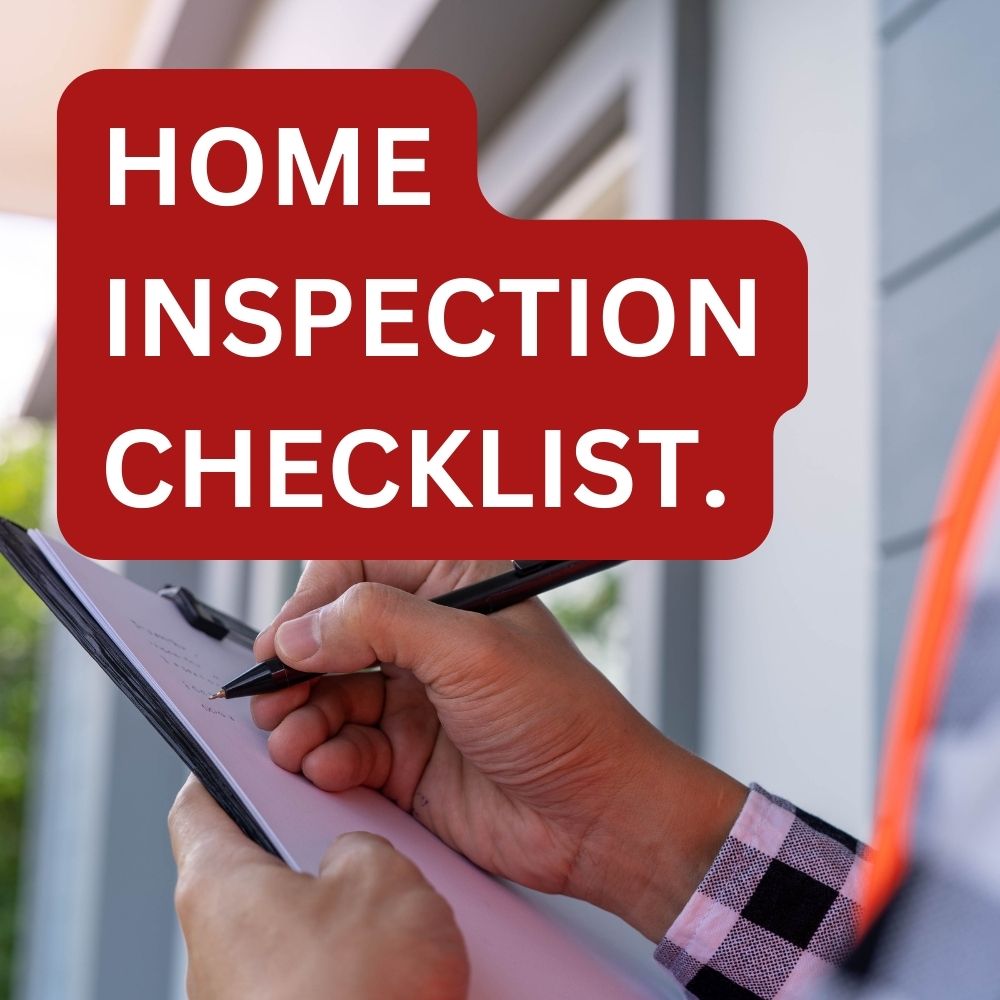Home Inspection Checklist
February 28th, 2024
Home Inspection Checklist When Selling Your Watford home.
Selling your Watford home can be stressful, but one crucial step that can give you peace of mind is a home inspection.
From checking for structural issues to examining heating and cooling systems, a home inspector leaves no stone unturned.
This article will discuss why a home inspection is essential, what to expect during the inspection, and how to prepare your home beforehand.
So, let’s dive in and ensure your home is in top shape for potential buyers!
What is a Home Inspection?
A home inspection is a crucial process in the property industry that thoroughly evaluates a property’s condition and features.
This inspection provides buyers with valuable insights into the property’s structural integrity, safety hazards, and energy efficiency. The inspection report generated from this process highlights potential issues that may require attention or repairs, allowing buyers to make informed decisions and negotiate terms with sellers. It is essential for both buyers and sellers as it helps assess the property’s overall health and ensure transparency in the transaction process.
Why is a Home Inspection Important When Selling Your Watford Home?
A home inspection is vital when selling your home as it provides insights into the property’s condition, helping you confidently navigate the home selling process.
Pre-sale inspection goes beyond just assessing the physical attributes of your property; it enhances your overall selling checklist. By conducting a thorough property evaluation, you can identify potential issues beforehand, making necessary repairs or disclosures.
This proactive approach not only increases the marketability of your home but also boosts its value. A comprehensive home value assessment from a professional inspector can facilitate smoother negotiations with potential buyers, instilling trust and transparency in the transaction process.
What Does a Home Inspector Look For?
During a home survey, a qualified inspector evaluates various aspects of the property, including its maintenance history, key features, overall condition, and structural integrity.
These assessments ensure the property is safe, habitable, and structurally sound for its occupants. Home inspectors meticulously inspect the plumbing systems, electrical wiring, HVAC systems, and other essential components to identify potential issues that may require attention.
Inspectors can carefully examine the property’s exterior and interior to detect signs of water damage, leaks, mould, or pest infestations that could pose health hazards or structural risks. Evaluating the property’s overall condition can help potential buyers make informed decisions and negotiate repairs or renovations before purchasing.
Structural Issues
Structural issues are among the primary concerns during a home inspection, involving assessments of the property’s foundation, walls, and overall structural integrity.
Assessing the structural integrity of a property is crucial as it directly impacts its stability and long-term durability. Common foundation issues that should be evaluated include cracks in the walls, uneven flooring, or sloping in the foundation.
Identifying these issues early on can help prevent further damage and costly repairs in the future. Necessary repairs may involve fixing foundation cracks, reinforcing walls, or even underpinning the foundation to ensure proper support.
Implementing potential improvements such as waterproofing, drainage systems, or seismic retrofitting can further enhance the property’s resilience and safety.
Roof and Attic
The roof and loft inspection focuses on assessing the roof’s condition, identifying signs of water damage, ensuring proper ventilation, and checking for potential issues.
This inspection process plays a crucial role in maintaining the integrity of the entire property. Regular roof and loft inspections allow homeowners to prevent costly repairs arising from neglected issues. Keeping up with roof maintenance helps to extend the roof’s lifespan and ensures that it continues to provide adequate protection against the elements.
Proper ventilation systems help to regulate temperature and moisture levels, reducing the risk of mould growth and structural damage. Adequate insulation is key for energy efficiency and comfort, so addressing any insulation deficiencies during inspections is essential.
Plumbing and Electrical Systems
Inspectors evaluate the plumbing and electrical systems to ensure functionality, safety, and compliance whilst also assessing the property’s HVAC systems for energy efficiency.
- Inspectors meticulously examine the plumbing fixtures, pipes, and connections during the inspection process to detect any leaks, corrosion, or potential hazards.
- They check electrical wiring, outlets, and panels for proper installation and adherence to safety codes.
Emphasis is placed on ensuring that all systems are in good working condition to avoid safety risks and potential energy wastage.
The HVAC system is inspected to ensure it is well-maintained, clean, and operating efficiently, as this can significantly impact the property’s overall energy consumption and comfort levels for occupants.
Heating and Cooling Systems
Heating and cooling systems undergo thorough inspections to assess their performance, energy efficiency, and potential repair needs, providing valuable insights for the property evaluation.
Energy efficiency ratings play a crucial role in determining HVAC systems’ overall effectiveness and cost-effectiveness. When evaluating a property, potential buyers and appraisers often consider the energy efficiency of the heating and cooling systems as it directly impacts utility bills and long-term sustainability.
Having accurate repair estimates helps in estimating future maintenance costs, which can influence the property’s value. Well-functioning heating and cooling systems provide comfort to occupants and enhance the property’s overall appeal and marketability.
Appliances
Appliances are examined during a home survey to ensure they are in working order, identify maintenance tasks, and verify any existing guarantee information.
- This survey involves checking the functionality of appliances such as fridges, cookers, dishwashers, and HVAC systems to determine if they operate efficiently and safely.
- Any necessary repairs or maintenance tasks are noted to ensure the appliances continue to function correctly. Inspectors will look into the guarantee details of each appliance to see if they are still covered, providing valuable information to the homeowner.
- Ensuring that appliances are in good working condition not only enhances the comfort and convenience of the property but also plays a crucial role in determining the overall valuation of the home.
Exterior and Interior Features
Inspectors assess a property’s exterior and interior features, focusing on aspects like house presentation, kerb appeal, and adherence to property boundaries.
During inspections, they pay close attention to the exterior elements, such as the condition of the roof, cladding, windows, and landscaping, to determine the property’s overall kerb appeal. Enhancements like fresh paint, well-maintained gardens, and updated outdoor fixtures can significantly boost a home’s attractiveness to potential buyers.
Inspectors verify property boundaries to ensure the land is accurately marked, and any encroachments are identified. A well-presented home not only increases the likelihood of a quick sale but also helps maximise its value in the real estate market.
Environmental Concerns
Environmental concerns such as pest control, radon testing, and mould inspection are essential for a comprehensive home inspection to ensure a safe and healthy living environment.
Pest control measures are critical in preventing property damage and health risks associated with pests. Regular inspections and proactive steps can help identify and address pest infestations before they escalate.
Similarly, radon testing procedures are crucial as radon is a colourless, odourless radioactive gas that can seep into homes and pose serious health risks. Identifying and mitigating radon levels can significantly reduce the risk of lung cancer.
Mould inspections are vital to protect indoor air quality and prevent respiratory issues. Addressing these environmental issues promptly is key to maintaining a safe and healthy home.
How to Prepare for a Home Inspection?
Preparing for a home inspection involves completing necessary repairs, decluttering the property, and ensuring a well-presented house that meets buyer expectations.
Seller responsibilities include addressing maintenance issues, ensuring all utilities work, and providing easy access to essential documents.
To create a positive first impression, consider freshening the paint and enhancing curb appeal with landscaping and staging rooms to showcase their potential.
Remember that cleanliness is key; a tidy and organised home can convey a sense of care and attention to detail, which can significantly impact buyers’ perceptions.
By taking these steps, you are preparing for the inspection and increasing the likelihood of a successful sale.
Clean and Declutter Your Home
Cleaning and decluttering your home are essential steps to prepare for a home inspection, showcasing a well-maintained property and ensuring a positive impression on potential buyers.
By organising your living spaces, you provide a sense of openness and freshness, which can help buyers envision themselves living in the space. Focus on removing personal items such as excess family photos or memorabilia to create a neutral canvas that appeals to a broader range of tastes.
Pay attention to minor details like dusting, vacuuming, and polishing surfaces to make the property look well-cared for. Remember, a clean and clutter-free environment allows your home’s best features to shine, making it more attractive to interested buyers.
Make Necessary Repairs
Addressing necessary repairs and improvements before a home inspection is crucial to enhance the property’s condition, potentially increasing its value and market appeal.
By tackling these repairs early on, homeowners can rectify any glaring issues that may deter potential buyers or result in costly concessions during negotiations.
Obtaining repair estimates can also clarify the financial aspect of the improvements needed, helping sellers budget effectively.
Conducting a thorough condition assessment allows for identifying critical fixes that could impact the property’s overall safety, functionality, and aesthetics.
Prioritising essential repairs ensures that resources are allocated efficiently to address the most pressing concerns, ultimately streamlining the selling process.
Provide Easy Access to All Areas
Ensuring easy access to all areas of the property is essential for a comprehensive home inspection, facilitating the inspector’s evaluation process and meeting buyer expectations.
Buyers rely on the inspection report to make informed decisions, and having seamless access to every part of the house ensures that the inspector can thoroughly assess its condition.
From the attic to the basement, each area plays a crucial role in determining the overall functionality and safety of the property. With unobstructed access, potential issues can be identified early on, allowing for timely repairs and saving both buyers and sellers from surprises down the road.
What to Expect During a Home Inspection?
A home inspection typically involves a detailed walk-through with the inspector, where buyers can address concerns, negotiate repairs, and understand the property’s condition and potential issues.
Throughout this process, buyers can take advantage of the opportunity to closely examine the property’s structural integrity, electrical systems, plumbing, and any other components that may impact their decision to purchase.
By uncovering potential issues, buyers can leverage this information during negotiations with the seller to either request necessary repairs or adjust the purchase price accordingly.
Compliance with disclosure requirements ensures that buyers are fully informed about the property’s history and any known defects, empowering them to make informed decisions about their investment.
Duration of the Inspection
The duration of a home inspection varies based on the property’s size and complexity, with sellers encouraged to cooperate and provide necessary information for a thorough assessment.
Seller cooperation is crucial in expediting the inspection process as their transparency and readiness allow inspectors to access all areas efficiently. By ensuring access to critical utilities and documents, sellers enable inspectors to carry out a comprehensive evaluation.
The efficiency of the property assessment greatly influences the inspection timeframe. Well-maintained properties with organised systems and documentation can streamline the inspection, leading to quicker completion. Sellers can support this by adequately preparing the property and addressing any potential issues in advance, facilitating a smooth and expedited inspection.
Walkthrough with the Inspector
The walk-through with the inspector involves a detailed examination of the property, highlighting key findings, potential safety hazards, and overall property evaluation that informs buyers’ decisions.
During the inspection, the inspector carefully examines the property’s structural integrity, checking for any signs of damage or wear that could affect its long-term durability. Crucial components such as the electrical, plumbing, HVAC, and roof are thoroughly assessed to ensure they are in proper working condition.
Safety hazards, such as mould, faulty wiring, or trip hazards, are identified to alert buyers of potential risks. By diligently scrutinising these elements, the property evaluation provides invaluable insights to buyers, empowering them to make well-informed decisions regarding their purchase.
What Happens After a Home Inspection?
After a home survey, the survey report is reviewed, and negotiations may occur between buyers and sellers regarding necessary repairs, affecting the completion requirements of the sale.
The negotiation process begins once both parties have thoroughly examined the survey report. Buyers may ask for repairs or credits based on the findings in the report, while sellers may make a counteroffer or agree to cover certain repair costs. Following the negotiation phase, buyers typically obtain repair estimates from trusted professionals to assess the scope and cost of the necessary work.
These estimates play a crucial role in determining the final terms of the sale and impacting the completion requirements that need to be met before the transaction is finalised.
Reviewing the Inspection Report
Reviewing the inspection report is essential after a home inspection to understand the property’s condition, address potential issues, and fulfil buyer disclosure requirements.
Thoroughly evaluating the inspection report allows buyers to make informed decisions regarding the property purchase. By carefully examining the assessment outcomes, individuals can identify any red flags or areas of concern that may impact the property’s value or safety. This step not only helps in negotiating repairs or adjustments but also ensures transparency in the selling process.
Meeting disclosure requirements showcases honesty and integrity, creating a solid foundation of trust between the seller and the potential buyer. It sets a standard of accountability and professionalism in real estate transactions, fostering a positive and ethical environment.
Negotiating Repairs with the Buyer
Negotiating repairs with the buyer post-inspection involves discussing repair estimates, addressing concerns, and leveraging negotiation strategies to reach a mutually beneficial agreement.
After presenting the repair estimates, it is essential to evaluate the buyer’s concerns and priorities carefully. Understanding what aspects of the home’s condition are most important to them can provide valuable insights into potential areas for compromise or adjustment.
Negotiation tactics such as highlighting the property’s strengths, offering alternative solutions, or demonstrating comparable market data can help build a persuasive case during the negotiation process. Maintaining a respectful and collaborative approach while considering factors like negotiation leverage and shared goals is crucial to ensure a fair and satisfactory agreement is reached.
Closing the Sale
Completing the sale after a home survey concludes the transaction, involving final steps such as title searches, permit history checks, and meeting warranty and completion requirements.
During this phase, the buyer’s lender typically coordinates with a title company to conduct a thorough search, ensuring that the property’s title is clear of any liens or legal issues. The property’s permit history is examined to confirm that all previous renovations or improvements were carried out with proper permits. This helps to prevent any future legal or financial complications.
Both parties must ensure compliance with any warranty information and completion requirements outlined in the purchase agreement to finalise the sale smoothly.


